What Is Web App Development? Everything You Need to Know in 2025

As we step into Web App Development in 2025, the speed of progress keeps increasing. This offers many opportunities for both experienced and new developers. Web application development isn’t just about coding. It’s also important to focus on developing a memorable digital experience for users, which often requires the skills of a user experience researcher. Developing web applications involves creativity, solving problems, and exploring endless possibilities.
So, what is web application development, and why does it matter in 2025? Let’s break down the basics of web app development, including why it’s important, how it works, the latest trends, and what you need to know to keep up in this fast-changing field.
A web application is software that works through an internet browser. Unlike desktop apps, which are installed on your computer, a web app is stored on a remote server. Sometimes called a Progressive Web App (PWA), it has multiple dynamic pages that let users interact through profiles.
Web apps are platform-independent and provide the same user experience on both mobile and desktop devices due to their nature and technical design. Most PWAs, especially mobile web apps, are usually built using HTML5 and Java. They are ideal for people who wish to launch MVPs fast and effectively because they are inexpensive to design.
The global web development market is projected to reach $10.5 billion by 2028, growing at a compound annual growth rate (CAGR) of 7.6%, according to a report by Market Research Future (2023).
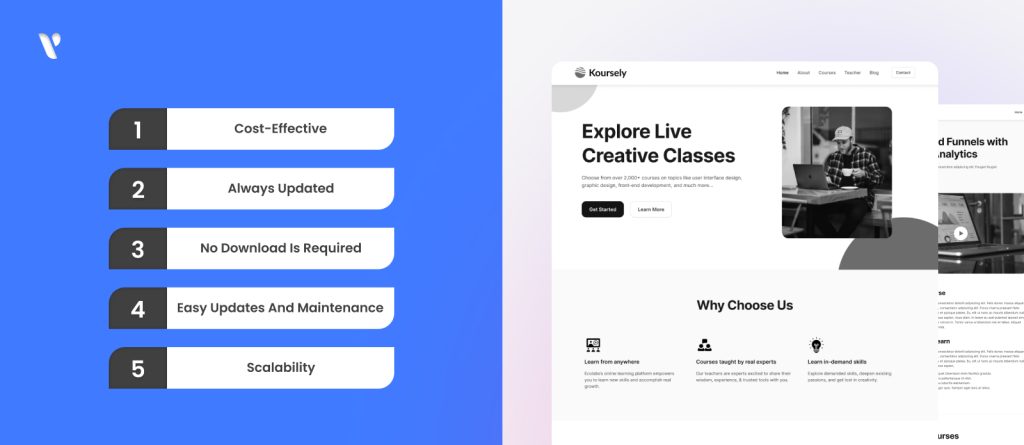
Here’s a simple 5-step guide to help you understand the Web App Development process without getting too technical:
This document serves as your roadmap before you begin development or hire a web applications developer. Include both a concept overview and a technical outline. Describe the goals you have for your app in the concept section. List the languages you want to use and the features you would like to see in your app in the technical area. Also, don’t forget to indicate the desired launch month and year, the development budget, and the amount of time you can commit to project management.
This is one of the more challenging parts of your web app development project. By now, you should have a clear idea of the languages and technologies you’ll use. To sum up, you need a JavaScript developer to handle both the front-end and back-end of your web app. If you’d rather have two separate developers, it’s a good idea to also bring in a Node.js specialist.
When hiring, make sure your ideal team includes a designer, business analyst, project manager, tester, and lead technical developers. Also, think about the developer’s location, their portfolio, their ability to meet deadlines, and the details of their non-disclosure agreement.
Once you’ve hired the developer, you can begin the technical steps. After figuring out and finalizing the app’s features, your designer will create the app screens and get your approval. These designs will then be used for the front-end development.
Frontend is the part of the web app development that users see and interact with. The backend is the server side, where most of the coding happens. The longest and most significant stage of development is this one. Maintain communication with your developer throughout this phase, monitor your development, and ensure that everything is completed on schedule.
You and your QA team need to thoroughly test the web app before it’s released to users. During the testing phase, make sure that:

In 2025, web apps must provide seamless, innovative, and user-centric experiences. With rising expectations, features like AI personalization, AR integration, and advanced security are now essential. The table below highlights these must-haves with practical examples to inspire modern web app development:
| Feature | Description | Examples |
| 1. Responsive Design | Adapts to any screen size for a seamless user experience. | A shopping website working smoothly on both mobile and desktop. |
| 2. Progressive Web App (PWA) | Provides offline access and app-like functionality. | Twitter Lite or Starbucks PWA. |
| 3. AI-Personalized Experience | Uses AI to customize content based on user behavior. | Netflix recommendations based on watch history. |
| 4. Voice Search Integration | Enables hands-free interaction through voice commands. | Google Search voice queries. |
| 5. Improved Security | Implements MFA and encryption for data protection. | Logging into Gmail with a password and a verification code |
| 6. Fast Loading Speed | Ensures quick page load times for better UX. | Amazon’s webpage loading instantly, even with large images. |
| 7. Accessibility Features | Supports screen readers, high contrast, and keyboard navigation. | Chatbots on banking websites help users check account balances or solve queries. |
| 8. AI Chatbots | Provides instant customer support through automation. | Chatbots on banking websites assisting users. |
| 9. Seamless Integration | Connects with third-party tools like payment gateways and APIs. | Paying for an order on a food delivery app using PayPal or Google Pay. |
| 10. Data Visualization Tools | Displays complex data in interactive charts. | Fitness apps showing progress with graphs. |
| 11. Sustainability Features | Displays complex data in interactive charts. | Fitness apps showing progress with graphs. |
| 12. Multilingual Support | Offers content in multiple languages for a global audience. | A news site providing articles in English, Spanish, and French. |
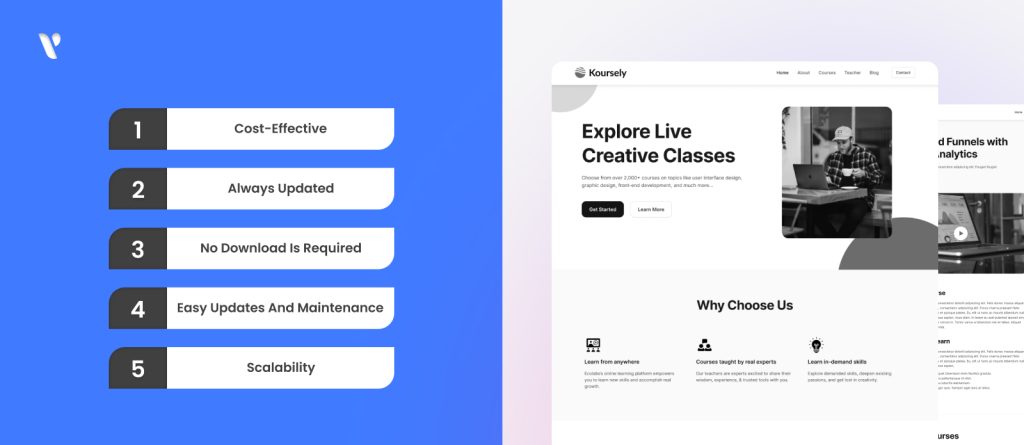
Web App Development offers many benefits to businesses and enterprises. Here are the most important ones:
Although it can be challenging to determine the precise cost, developing a web app is typically less expensive than developing mobile apps. Because web apps just need one version to function on all operating platforms, they take less time and effort to develop. So, if you’re on a tight budget but want to use the latest software for your business, web app development is a smart choice.
Web apps don’t need updates as often as regular apps. The website or URL for the app is updated to the latest version. Since everyone uses the same URL to access the web app, all users always have the most current version
Users can access the app through a web browser without downloading it, avoiding extra fees. It works across multiple browsers and devices, including laptops, desktops, and mobiles.
Since web apps are hosted on servers, updates happen instantly. Users don’t need to download or install anything in order to receive the most recent features and security updates. This assures that your app remain safe and updated.
As businesses expand, their needs also increase. Web apps can be easily scaled by adding more server resources or using cloud services. This helps them manage more traffic and users without needing big changes.
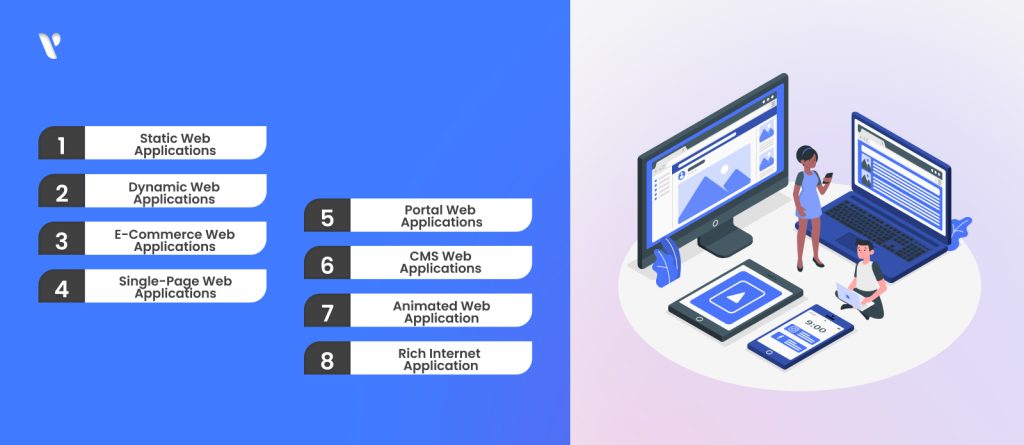
Web apps are now an essential part of both business and daily life, providing different functions to meet various needs. Here’s a quick look at the main types of web apps:
For both developers and businesses, it is essential to understand the distinction between websites and web applications. Despite their apparent similarities, they differ in their basic architecture, functionality, and purpose. The table below outlines the key differences to help clarify their unique characteristics:
| Aspect | Web Application | Website |
| Definition | A software program accessible through a browser that allows user interaction and performs specific tasks. | A collection of interlinked web pages designed to share information with users. |
| Primary Purpose | Offers functionality and user interaction (e.g., forms, dashboards, tools). | Provides static or dynamic content for informational or educational purposes. |
| User Interaction | High interaction; users can input data and receive personalized results. | Limited interaction; mostly read-only content like blogs, news, or corporate information. |
| Technology Used | Often uses complex frameworks, APIs, and backend programming (e.g., React, Angular, Node.js). | Primarily built with basic web technologies (e.g., HTML, CSS, JavaScript) and Content Management Systems. |
| Examples | Google Docs, Facebook, Gmail | Wikipedia, news sites, business landing pages |
| Data Handling | Processes and stores user data, often requiring authentication. | Rarely processes user data, primarily delivers content. |
| Offline Access | May provide limited offline functionality with tools like Service Workers. | Generally requires an active internet connection to access content. |
| Development Complexity | High, due to the need for interactive features, server-side logic, and scalability. | Relatively low, focused on content layout and design. |
As we have discussed above, the distinction between websites and web applications, and understanding the differences between web apps and mobile apps are equally important if you’re venturing into app development or deciding which type of app to use or create. Here’s a simple and interesting breakdown of the key points:
| Aspect | Web App | Mobile App |
| 1. Accessibility | -Accessible through web browsers on any device (e.g., Chrome, Safari). | -Requires downloading and installation from app stores like Google Play or Apple App Store. |
| -No installation is necessary, making it easy to access. | -Designed to work directly on specific devices (e.g., smartphones, tablets). | |
| 2. Internet Dependency | -Typically requires an internet connection to function effectively. | -Can work offline if features are downloaded or preloaded. |
| -Offline capabilities are limited for most web apps. | -Offers better offline functionality depending on the app. | |
| 3. Development Cost | -Cheaper to develop as it’s created once and works on all devices with a browser. | -More expensive since separate versions for iOS and Android are needed. |
| -Requires fewer resources for updates and maintenance. | -Offers a higher-quality experience but with added development costs. | |
| 4. Updates | -Updates are applied instantly on the server side; users see the latest version by refreshing. | -Updates must be downloaded manually or automatically via app stores. |
| -No user action is required for updates. | -Users may face delays if they don’t update the app. | |
| 5. Performance | -Can be slower due to browser limitations and varying device compatibility. | -Optimized for specific device hardware, ensuring better speed and responsiveness. |
| -May lack advanced features like push notifications or hardware access. | -Provides a richer experience with features like camera access and notifications. |
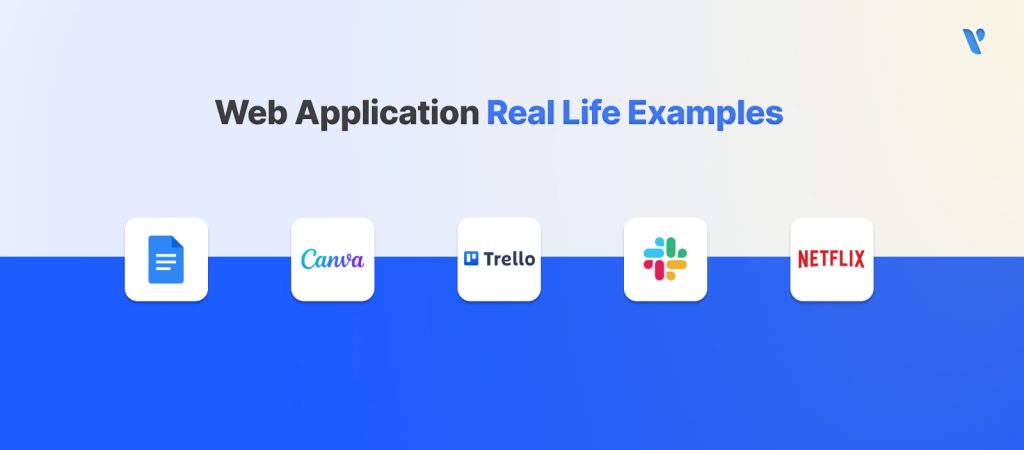
There are many successful web apps, like Gmail, Facebook, and Microsoft Office. Here are the best examples of web applications:
Google Docs introduced word processing online, improving the way we work with documents. It enables real-time document creation, editing, and collaboration among users. Google Docs highlights how online programs may replace desktop software by offering convenience and collaborative capabilities, all while being compatible with several devices and offering cloud storage and simple sharing.
Canva has made graphic design easy for everyone, no matter their skill level. It’s an online tool that provides templates for social media posts, presentations, flyers, and more. Canva is a good example of a web app development that uses the cloud to let users create professional designs without needing expensive software.
Trello is an online platform that facilitates team project management. It tracks tasks and workflows using cards, lists, and boards. Users may make cards for specific activities, add lists to display work phases, and set up boards for various projects. It’s easy to rearrange cards, assign tasks, establish deadlines, and add files or notes due to the drag-and-drop tool. Trello also offers customizable connections, checklists, and labels to satisfy the different project requirements.
The way teams collaborate has been transformed by the communication and teamwork tool Slack. Both in-office and remote teams need it because it integrates video calls, file sharing, and messaging into a single tool. Its connections with other services make it a central place for team productivity.
A popular online streaming service, Netflix offers a vast library of movies, TV shows, documentaries, and original content. Smart TVs, tablets, smartphones, and PCs can all display it with a web browser. Custom suggestions are provided by Netflix based on your interests and viewing preferences. High-quality, ad-free streaming in a variety of genres and languages is available to subscribers.
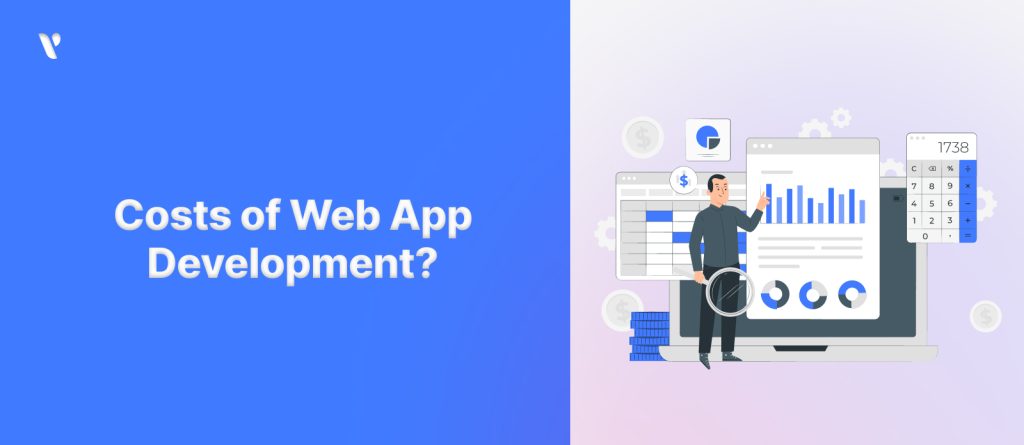
Estimating the cost of web app development is important and needs careful thought. A basic web app can cost anywhere from $5,000 to over $250,000.
You can get a rough estimate by figuring out what kind of app you’re making. Web apps are generally grouped into three categories based on how complex they are.
| App complexity | Estimated cost | Development time |
| Single web app | $3,000 – 5,000 | Less than 2 months |
| Medium web app | $5,000 – $10,000 | Average 3 – 4 months |
| Complex web app | $10,000 – $20,000+ | Over 4 months |
Web App Development can be costly, but there are ways to manage and cut costs while still maintaining quality. Here are some helpful tips:
Creating an MVP (minimum viable product) lets you launch a product with enough features for early users without spending a lot of money. You can make improvements as needed and invest more based on what clients say.

Web app development can become more affordable and valuable through using third-party solutions. For example, you can use payment gateway APIs like PayPal, Stripe, or Google Pay if you’re developing an app that manages financial transactions. Other features like chat, content management systems (CMS), and maps can also be used with this method. You can either integrate these tools right away or adjust them to fit your app’s design.
As the product owner, you’ll team up with experts who will assess your company’s needs and goals, clarify what the product requires, and create a clear plan for implementation. Once this phase is complete, you’ll have all the project details organized and receive an accurate estimate of the cost of developing the web app.
Now that you understand the key points of Web App Development, it’s time to bring your idea to life. Creating a web application involves several steps. This guide will help simplify the process and increase your chances of success. Be sure to cover everything from design and development to testing and launching.
Focus on user experience, security, and scalability to build an application that works well and is easy to use. With YeasiTech you can develop a web application that satisfies your users’ needs and supports your business goals.
If you need a team to create strong, scalable web apps for you, we can help! Contact us today to find out how YeasiTech Developers can build your web apps faster and cheaper than traditional development agencies.
Web app development is the process of writing programs that are accessible by an internet browser and operate on distant servers. Web applications may be used instantly online and don’t require downloads, in contrast to desktop programs.
A website shares information with users, while a web app offers interactive features and services. Websites are mainly for information, but web apps let users do tasks like online shopping, managing finances, or social networking.
The time to develop a web app depends on its complexity, features, and the development approach. Simple apps may take a few weeks, while complex ones could take several months.
Key trends in 2025 include the growth of AI and machine learning, the rise of serverless architectures, better security features, and the increasing use of Progressive Web Apps (PWAs) and Single Page Applications (SPAs).
Web apps work on any device with a web browser, making them platform-independent. They are easier to maintain because updates are done on the server, so users don’t need to install anything. Plus, web apps allow smooth access to services across different devices.
Progressive Web App (PWA) development focuses on creating web applications that offer a native app-like experience. PWAs are fast, responsive, work offline, and can be installed on devices without needing an app store
To learn web app development, start with HTML, CSS, and JavaScript. Then, explore frameworks like React, Angular, or Vue.js for the frontend and Node.js, Django, or Ruby on Rails for the backend. Online courses, coding bootcamps, and hands-on projects are great ways to build your skills.
The cost of web app development varies based on complexity, features, and development team location. A simple web app may cost $3,000–$10,000, while a complex one can exceed $20,000–$50,000. Custom enterprise solutions may cost even more.
The choice depends on your goals. Web development is ideal for creating accessible, platform-independent solutions, while app development (mobile or desktop) is better for performance-intensive, offline, or device-integrated applications.
Web app development creates browser-based applications that work across devices, while mobile app development builds platform-specific apps (iOS/Android). Web apps are cost-effective and easy to maintain, but mobile apps provide better performance and offline capabilities.
Web development includes both websites and web applications, whereas web app development specifically focuses on creating dynamic, interactive applications with advanced functionality beyond static web pages.
YeasiTech is a trusted IT service partner with 8+ years of experience, empowering 250+ businesses with scalable web, mobile and AI solutions.
Explore related topics to broaden your understanding and gain actionable insights that can transform your strategies.